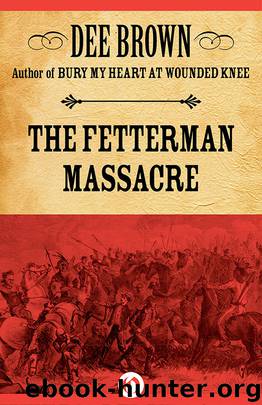The Fetterman Massacre by Dee Brown

Author:Dee Brown [Brown, Dee]
Language: eng
Format: epub
ISBN: 978-1-4532-7416-3
Publisher: Open Road Media
Published: 2012-09-28T01:05:00+00:00
VIII. November:
DEER RUTTING MOON
Because the country was broken, because most of the officers had not been with me in reconnaissances and had recently arrived at post entirely unused to Indian warfare, because I knew the Indians to be in large numbers, I would not authorize them to make hazardous adventures. … I did (as I believed) fail to have the confidence of some officers. Few came from Omaha or Laramie without prejudice, believing I was not doing enough fighting.1
LATE ON NOVEMBER 1, THE last Montana-bound civilian train of the season was camped outside the fort. This party had met with little Indian resistance on the journey up from Laramie, and some of the men had grown careless enough to sit around campfires after dark, playing cards by the light of the flames. About nine o’clock on this evening a band of Indians crept close upon them in the surrounding darkness, and without warning fired upon the card players. Three men were wounded, one fatally, in the first fusillade. A few moments later signal fires appeared on hills around the fort, and Indians could be seen dancing around them.
“Colonel Carrington concluded to try his mountain howitzer on the Indian dancers,” teamster John Bratt later recorded. “After a few shots, the gunners got range on some of the Indian fires, and many fires were extinguished and some dancers’ lives went out with them.”2 The colonel also dispatched a skirmish party, but no trace of the night attackers was found.
Two days later one of the two cavalry companies assigned to Phil Kearny in August finally arrived from Laramie—sixty-three men of Company C under command of Lieutenant Horatio S. Bingham, a young Minnesotan with Civil War experience. For Bingham and twenty-seven of his men, this would be their last post assignment. The lieutenant had less than a month to live, and Company C would suffer the heaviest loss of any of the five companies represented in the detachment which marched out with Fetterman on December 21. They were armed with obsolete Enfield rifles and Starr carbines.
Accompanying Bingham’s cavalrymen from Fort Laramie was the man who would lead so many of them to their deaths—Captain William J. Fetterman. While Carrington as nominal commander of the 18th Regiment had remained in Ohio and Indiana through most of the Civil War, Fetterman had been winning honors in combat. In the spring of 1862, Fetterman commanded Company A of the 2nd Battalion during the siege of Corinth; later that year he was cited for gallantry at Stone’s River after thirty-six hours of continuous fighting. As commander of the 2nd Battalion he fought throughout most of Sherman’s Georgia campaign of 1864—Resaca, Kennesaw Mountain, Peach Tree Creek, Jonesboro, the siege of Atlanta. Official dispatches were filled with numerous commendatory references: “Captain Fetterman’s command marched to my assistance with great promptness … conspicuous for gallantry and bravery … displayed great gallantry and spirit … the conduct of Captain Fetterman in throwing up a salient and maintaining his positions against repeated attempts to dislodge him by the enemy, is worthy of particular notice.
Download
This site does not store any files on its server. We only index and link to content provided by other sites. Please contact the content providers to delete copyright contents if any and email us, we'll remove relevant links or contents immediately.
| Africa | Americas |
| Arctic & Antarctica | Asia |
| Australia & Oceania | Europe |
| Middle East | Russia |
| United States | World |
| Ancient Civilizations | Military |
| Historical Study & Educational Resources |
Cat's cradle by Kurt Vonnegut(14756)
Pimp by Iceberg Slim(13772)
Underground: A Human History of the Worlds Beneath Our Feet by Will Hunt(11832)
4 3 2 1: A Novel by Paul Auster(11784)
The Radium Girls by Kate Moore(11616)
Wiseguy by Nicholas Pileggi(5313)
American History Stories, Volume III (Yesterday's Classics) by Pratt Mara L(5132)
Perfect Rhythm by Jae(5066)
The Fire Next Time by James Baldwin(5015)
Paper Towns by Green John(4786)
Pale Blue Dot by Carl Sagan(4613)
A Higher Loyalty: Truth, Lies, and Leadership by James Comey(4546)
The Mayflower and the Pilgrims' New World by Nathaniel Philbrick(4277)
The Doomsday Machine by Daniel Ellsberg(4241)
Killers of the Flower Moon: The Osage Murders and the Birth of the FBI by David Grann(4186)
The Sympathizer by Viet Thanh Nguyen(4091)
Too Much and Not the Mood by Durga Chew-Bose(4088)
The Borden Murders by Sarah Miller(4011)
Sticky Fingers by Joe Hagan(3908)
